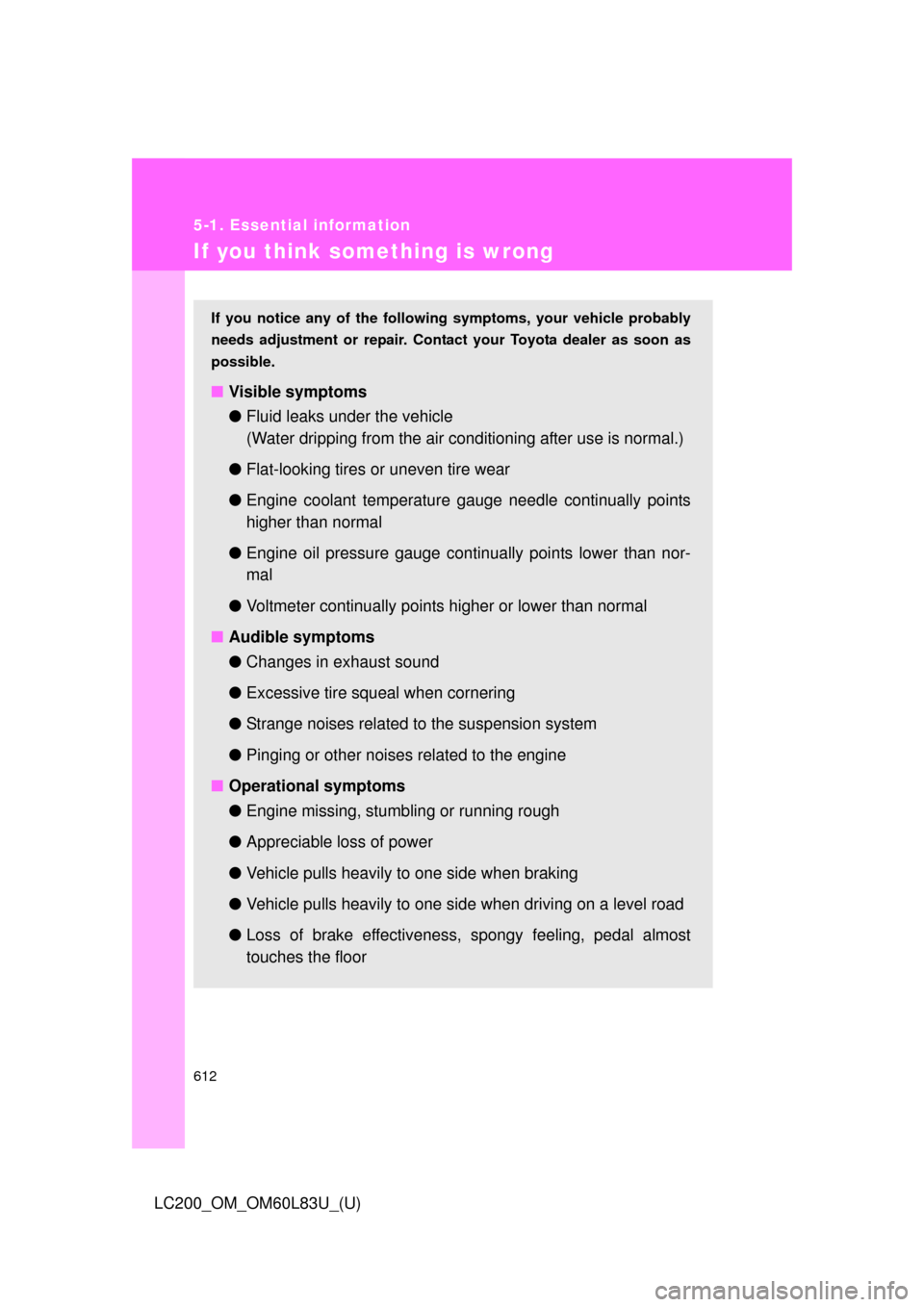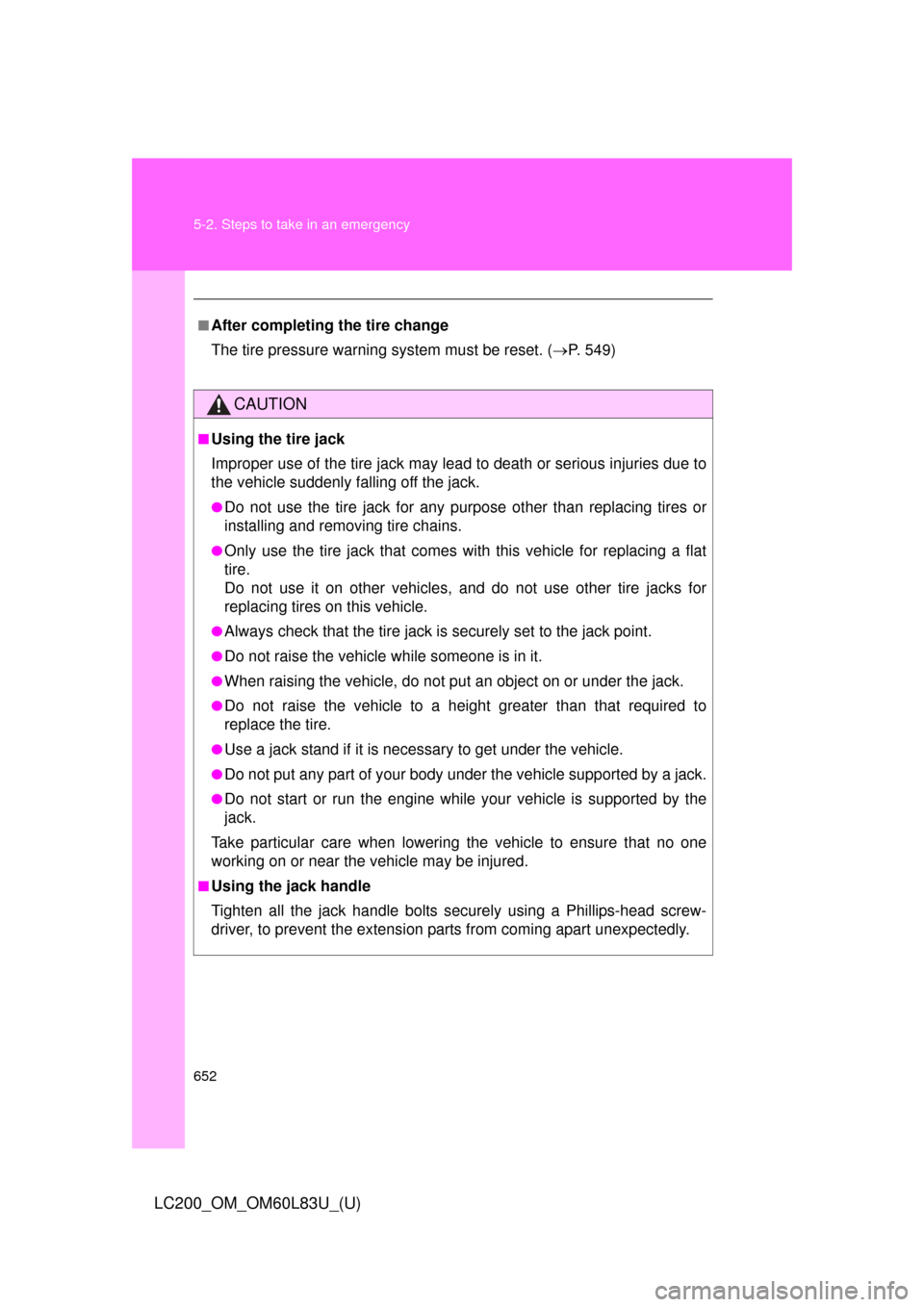Page 527 of 728
527
4-2. Maintenance
4
Maintenance and care
LC200_OM_OM60L83U_(U)
Vehicle exterior
ItemsCheck points
Doors • Operate smoothly?
Engine hood • The lock system works properly?
Fluid leaks • Is there any leakage after park-
ing?
Tires • Is the tire inflation pressure cor-
rect?
• The tires should not be dam- aged or excessively worn.
• Have the tires been rotated according to the maintenance
schedule?
• The wheel nuts should not be loose.
Windshield wipers/rear window
wiper • The wiper blades should not show
any signs of cracking, splitting,
wear, contamination or deforma-
tion.
• The wiper blades should clear the
windshield/rear window without
streaking or skipping.
CAUTION
■ If the engine is running
Turn off the engine and ensure that there is adequate ventilation before per-
forming maintenance checks.
Page 605 of 728
5
When trouble arises
605
5-1. Essential information
LC200_OM_OM60L83U_(U)
If your vehicle needs to be towed
Situations needs to contact dealers before towingThe following may indicate a problem with your transmission. Contact
your Toyota dealer or commercial towing service before towing.
● The engine is running but the vehicle will not move.
● The vehicle makes an abnormal sound.
Towing with a sling-type truck
Do not tow with a sling-type truck
to prevent body damage.
If towing is necessary, we recommend having your vehicle towed by
your Toyota dealer or commercial towing service, using a lift-type
truck or a flatbed truck.
Use a safety chain system for all to wing, and abide by all state/pro-
vincial and local laws.
Page 612 of 728

612
5-1. Essential information
LC200_OM_OM60L83U_(U)
If you think something is wrong
If you notice any of the following symptoms, your vehicle probably
needs adjustment or repair. Contact your Toyota dealer as soon as
possible.
■ Visible symptoms
●Fluid leaks under the vehicle
(Water dripping from the air cond itioning after use is normal.)
● Flat-looking tires or uneven tire wear
● Engine coolant temperature g auge needle continually points
higher than normal
● Engine oil pressure gauge continually points lower than nor-
mal
● Voltmeter continually points higher or lower than normal
■ Audible symptoms
●Changes in exhaust sound
● Excessive tire squeal when cornering
● Strange noises related to the suspension system
● Pinging or other noises related to the engine
■ Operational symptoms
●Engine missing, stumbling or running rough
● Appreciable loss of power
● Vehicle pulls heavily to one side when braking
● Vehicle pulls heavily to one side when driving on a level road
● Loss of brake effectiveness, s pongy feeling, pedal almost
touches the floor
Page 652 of 728

652 5-2. Steps to take in an emergency
LC200_OM_OM60L83U_(U)
■After completing the tire change
The tire pressure warning system must be reset. ( P. 549)
CAUTION
■Using the tire jack
Improper use of the tire jack may lead to death or serious injuries due to
the vehicle suddenly falling off the jack.
●Do not use the tire jack for any pu rpose other than replacing tires or
installing and removing tire chains.
●Only use the tire jack that comes with this vehicle for replacing a flat
tire.
Do not use it on other vehicles, and do not use other tire jacks for
replacing tires on this vehicle.
●Always check that the tire jack is securely set to the jack point.
●Do not raise the vehicle while someone is in it.
●When raising the vehicle, do not put an object on or under the jack.
●Do not raise the vehicle to a hei ght greater than that required to
replace the tire.
●Use a jack stand if it is necessary to get under the vehicle.
●Do not put any part of your body under the vehicle supported by a jack.
●Do not start or run the engine while your vehicle is supported by the
jack.
Take particular care when lowering the vehicle to ensure that no one
working on or near the vehicle may be injured.
■Using the jack handle
Tighten all the jack handle bolts securely using a Phillips-head screw-
driver, to prevent the extension pa rts from coming apart unexpectedly.
Page 726 of 728
726
LC200_OM_OM60L83U_(U)
What to do if...
What to do if...
A tire puncturesP. 641If you have a flat tire
The engine does not start
P. 108Engine immobilizer system
P. 655If the engine will not start
P. 662If the battery is discharged
The shift lever cannot be
moved outP. 657If the shift lever cannot be shifted
from “P”
The engine coolant temperature
gauge enters the red zone
Steam can be seen coming
from under the hood
P. 665If your vehicle overheats
The key is lostP. 658If you lose your keys
The battery runs outP. 662If the battery is discharged
The doors cannot be lockedP. 4 7Side doors
P. 5 2Back door
The horn begins to soundP. 1 1 0Alarm
The vehicle is stuck in mud
or sandP. 668If the vehicle becomes stuck
The warning light or indi-
cator light comes onP. 614If a warning light turns on or a
warning buzzer sounds...